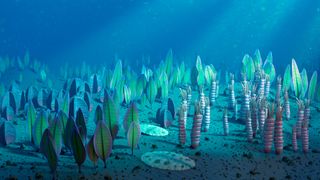They looked nothing like us, but their genes live inside us still.

Ediacaran creatures may have been more similar to modern animals than previously thought.
(Image credit: Mark Garlick/Science Photo Library/Getty)
By Cameron Duke March 23, 2021
More than half a billion years ago, headless sea creatures that looked like leaves, teardrops and coils of rope trawled the primeval seas.
Although these primordial animals looked nothing like us, some of our most important genes may be 555-million-year-old relics from these long-lost creatures, according to a new study.
The study found that Earth's earliest and most primitive animals may have had genes that code for body symmetry, sensory organs and immune systems that are still around today.
Related: Images: Bizarre, primordial sea creatures dominated the Ediacaran era
By Cameron Duke March 23, 2021
More than half a billion years ago, headless sea creatures that looked like leaves, teardrops and coils of rope trawled the primeval seas.
Although these primordial animals looked nothing like us, some of our most important genes may be 555-million-year-old relics from these long-lost creatures, according to a new study.
The study found that Earth's earliest and most primitive animals may have had genes that code for body symmetry, sensory organs and immune systems that are still around today.
Related: Images: Bizarre, primordial sea creatures dominated the Ediacaran era
Strange creatures
Animals of the Ediacaran era were flat, bottom-feeding ocean dwellers that scoured the seafloor. They were truly otherworldly in appearance; some, such as shape-shifting rangeomorphs, looked so much like leaves that scientists debated for decades whether the creatures were in fact animals, Live Science previously reported.
"These animals are super weird, and they don't look like what we expect animals should look like," study lead author Scott Evans, a post-doctoral researcher at Virginia Tech, told Live Science.
Most of these Ediacaran animals would have been simplistic, perhaps one or two steps more advanced than sponges in that they had nerves and a gut. But in their time, they represented a huge evolutionary leap. Animals from this era were the first multicellular animals to exist, making them the distant ancestors of all modern animals.
Their weirdness and lack of distinct characteristics have made it difficult for scientists to determine the creatures' positions on the tree of life. So, for the new study, Evans and his co-authors — Mary Droser, a professor of geology at the University of California, Riverside, and Douglas Erwin, a research biologist at the National Museum of Natural History in Washington D.C. — examined fossils from four genera representing the diversity of the more than 40 known Ediacaran species from fossil sites in the Australian Outback.
Their goal was to identify clues about how these primitive animals were related and what species came after them.
The four types of creatures they looked at were: the veiny-looking, oval-shaped Dickinsonia; the teardrop-shaped Kimberella; the completely immobile, pinwheel-shaped Tribrachidium; and Ikaria, a wormlike genus Evans himself helped discover.
These four ambassadors from the Ediacaran era showed that these animals are not as different from modern animals as once believed. Despite lacking heads and legs, the animals still possessed some basic features that persist today. For example, three of the four were symmetrical from left to right and had segmented bodies.
Although it is not possible to directly examine the genetic makeup of these creatures, the presence of developmental characteristics, like symmetry and body segmentation, suggests that many of the most important genes in modern animals — master controllers known as high-level regulatory genes — were present in these ancient animals.
"Developmental biologists have learned that everything with a front and a back, or a left and a right, is using the same genetic elements to establish a front and a back or a left and a right," Evans said. "We can use that fact to say that if these Ediacaran animals have these same characteristics, then they are probably controlled by the same genes."
Genetic scaffolding
Regulatory genes tell other genes what to do. So, while a modern animal has genes that encode for eyes, it also has a set of regulatory genes that tell the body where those eyes go. Regulatory genes dictate which body segments become heads and which become feet. Dickinsonia’s symmetrical body with raised ridges extending from the midline suggests that the genetic scaffolding for a complex body was already in place, even if all of those body segments were functionally the same.
This is the same genetic scaffolding found in all animals with symmetrical bodies today.
"The fact that we can say these genes were operating in something that's been extinct for half a billion years is fascinating to me," Evans said in a statement.
The study, which was published Feb. 24 in the journal Proceedings of the Royal Society B, doesn't stop with regulatory genes. The researchers predicted that many of the genes responsible for more complex traits, such as nerves and muscles, were likely hidden within the genomes of the Ediacaran animals, too.
Fossil evidence suggests that many of these animals actively foraged for food rather than passively filtering it from the environment. That indirectly suggests that they carried genes that could build rudimentary nervous systems and sensory organs that would enable them to detect and collect food from the seafloor.
And some fossils of Dickinsonia bear scars. This suggests these animals were able to repair their own damaged tissues through the process of programmed cell death — again, all functions that are controlled by genes that are an integral part of an animal's immune system.
Originally published on Live Science.
No comments:
Post a Comment